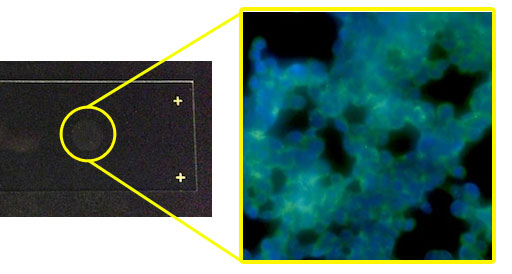What the Heck are Cytospins?
Gail M. Seigel, PhD, University at Buffalo — Published: July 23, 2013

Fluorescent staining of Retinal Cell Line (R28) Cytospin.Retinal Cell Line (R28) Cytospin with “button” of cells and resulting microscope image of cells stained for EpCAM (green) and counterstained with DAPI (blue).
“How can I maximize my research resources during these financially difficult times?” It is a question that many of us ask as we hunker down with our austerity budgets. We have needs for personnel, equipment, supplies and travel that require us to do precarious balancing acts with our ledgers in order to keep our labs productive and efficient.
What does this have to do with cytospins and what the heck are they anyway?
Have you ever wanted to run an experiment with a cell line, but were intimidated by the time, expense and acrobatics of cell culture? If you want to grow a cell line yourself, you need to train or hire scientists experienced in cell culture, sterile technique and autoclaving. You have to hope that the latest fungal infestation doesn’t wedge itself between your incubator shelves, filling your cell culture vessel with microscopic dreadlocks.
Is there a way to conduct immunostaining and in situ hybridization without the time and expense of cell culture?
Yes, and the answer is cytospins!
Thanks to the modern marvel of KeraFAST and The Investigator’s Annexe, you can now purchase retinal cells already fixed on slides and ready for experiments. These cytospins of R28 cells or E1A-NR.3 cells have been lovingly prepared by a ten minute fixation in a glycerol-acetone-isopropanol solution, followed by cytospin centrifugation for five minutes. The result is a small button of fixed cells on a slide, ready for any manner of immunocytochemistry or in situ hybridization. We use extra-sticky slides to ensure adherence of the cells to the slide through your staining incubations and rinses.
You no longer have to worry about your cell culture medium boiling over in the autoclave or that pesky leak in your incubator’s CO2 line. We have braved the blizzards of Buffalo to prepare ready-to-use retinal cells, already on slides, for your experiments. No need to thank us….just buy them!
Tags:
Cytospin, Retinal Cells, E1A-NR.3 Cell Line, R28 Cell Line.
References:
- Cassidy L, Choi M, Meyer J, and Seigel GM, Immunoreactivity of Pluripotent Markers SSEA-5 and L1CAM in Human Tumors, Teratomas, and Induced Pluripotent Stem Cells. Journal of Biomarkers, Volume 2013 (2013), Article ID 960862



